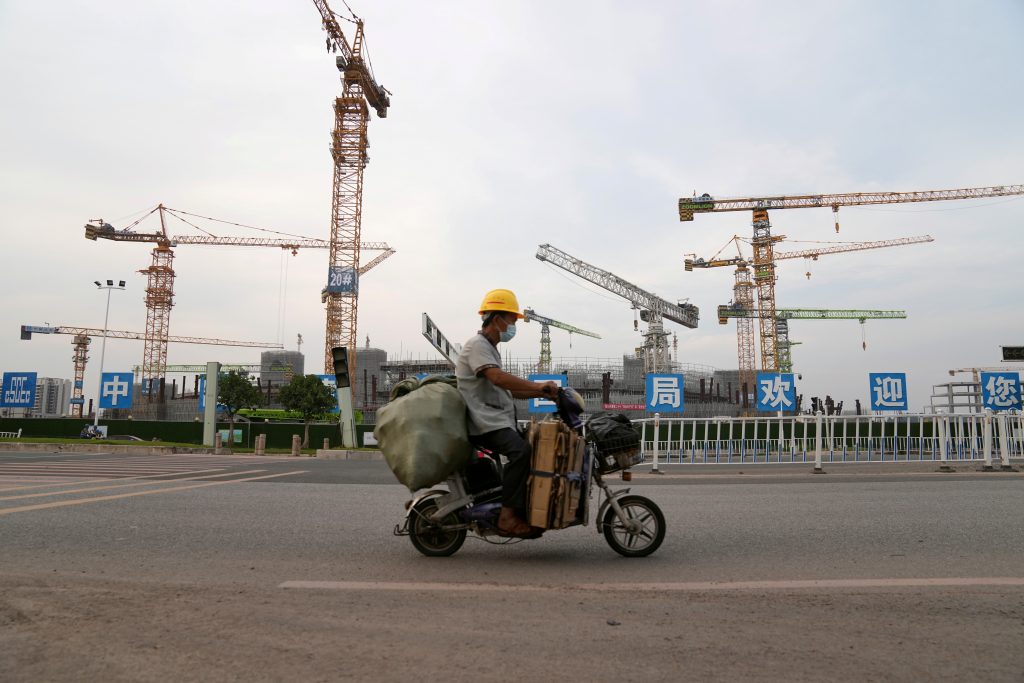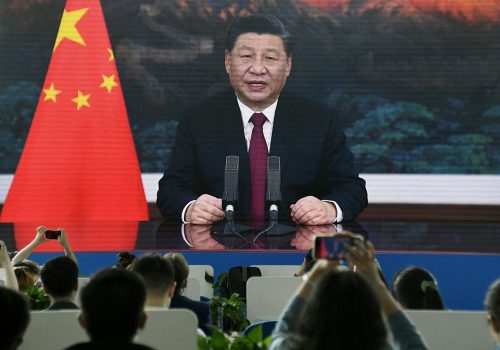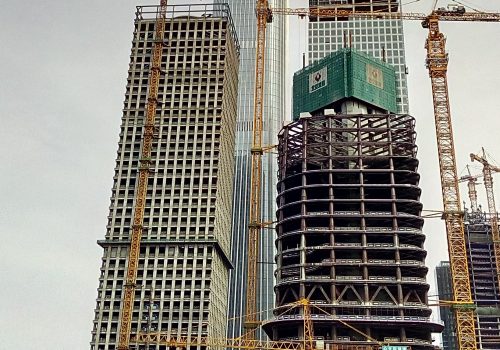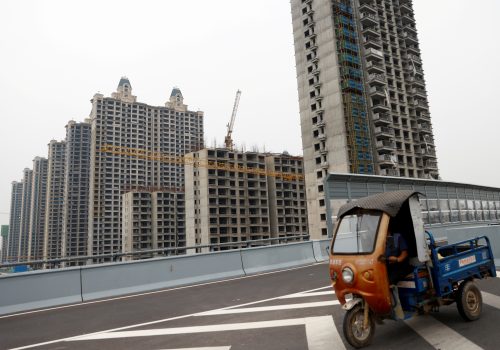“Unstable, unbalanced, uncoordinated and unsustainable.” That’s how former Chinese Premier Wen Jiabao once described China’s economic growth, revealing the shaky truth that lies behind impressive headline growth figures: China’s dependence on increases in debt, in particular corporate debt, which has soared to record highs in recent years. The Chinese government has been trying to slow and even reverse the growth of debt, consistent with advice from the International Monetary Fund and the World Bank, among others. Such efforts have not been successful—until recently. Chinese President Xi Jinping’s latest effort to cut down on debt, or deleverage, seems to be making progress, but at the steep cost of slower growth. Global economies must prepare accordingly for the coming Chinese slowdown.
China’s non-financial-sector debt—incurred by the government, corporate, and household sectors—reached a record level of 272 percent of China’s gross domestic product (GDP) in 2020. But since then, Chinese companies have deleveraged noticeably under pressure from both the government and the pandemic economy. Even despite a small increase in the debt from the central and local governments (accounting for 45.6 percent of GDP) and local government financing vehicles which borrow to raise additional money for local governments (accounting for another 36.4 percent), corporate deleveraging has reduced China’s debt by 7 percentage points to 265 percent of GDP in the third quarter of 2021.
At the center of the corporate deleveraging campaign is the August 2020 “three red lines” policy which states that a property company cannot borrow new debt unless its debt-to-asset ratio is less than 70 percent, its net debt-to-equity ratio is less than 100 percent, and its cash-to-short-term-debt ratio is more than 100 percent.
Many property developers have not met those “red lines” requirements and therefore have not been able to borrow new debt to refinance old debt or carry out normal operations. As a result, they’ve fallen into debt distress—all together, they have about 33.5 trillion yuan ($5.24 trillion) in debt, which is equivalent to nearly a third of China’s GDP. The most visible case has been Evergrande which has about $300 billion of liabilities; it has been restructuring its domestic liabilities including bank loans and onshore bonds while managing to pay interest on offshore dollar bonds at the end of the grace period. Other developers such as Fantasia Holdings Group, Modern Land China, R&F Properties, Sinic Holdings Group, and China Properties Group are likely to follow Evergrande’s footsteps.
This approach appears to be consistent with China’s go-to strategy to manage a recent spike in corporate debt crises: China prefers pre-default restructuring if possible, especially vis-à-vis international creditors, while encouraging state-owned companies to buy assets from the stricken developers to help them deal with their financial obligations. Moreover, Chinese authorities stand ready to ease their policies enough to prevent the distresses of those developers from spreading to the whole real estate sector, or to other sectors, causing systemic financial instability. This strategy is China’s attempt to instill discipline in its financial markets but in a controlled environment.
China has also tried to rein in speculative investment in property by making it more difficult to purchase real estate for investment purposes. Some 96 percent of urban households in China have purchased one house (the US homeownership rate is now 65.4 percent), 31 percent have purchased two properties, and 10.5 percent have purchased three or more, according to a 2019 central bank survey. China plans to impose a property tax in some regions in pursuit of its “common prosperity” goal to more evenly distribute wealth across the population. This tax has been discussed for twenty years, but resistance at various levels of government has held it back. So far the national government has instituted trial programs only in Shanghai (at 0.4 percent to 0.6 percent of the value of second homes) and Chongqing (at 0.5 percent to 1.2 percent of the value of existing stand-alone houses and high-end properties). When rolled out nationwide, the property tax may also reduce local governments’ dependence on land sales and borrowing through local government financing vehicles—helping to promote the goal of deleveraging.
China’s deleveraging effort also includes its crackdown on lending and borrowing that takes place outside of banking regulations through instruments such as entrusted loans, trust loans, and undiscounted bankers’ acceptances. These transactions are not transparent and lack supervision. China has made good progress in this area as well; it has reduced the outstanding amount of these “shadow banking” loans by about 18 percent since 2018 to just more than 20 trillion yuan ($3.1 trillion) in 2020. China has also cracked down on the use of wealth management products (WMPs) as a poorly supervised way to raise funds. The country’s latest regulation, issued in June, prohibits banks and wealth management companies from using the cash raised by WMPs to invest in the stock and low-rated bond markets. The regulation also restricts WMPs to a maximum leverage ratio of 120 percent. At present, WMPs amount to about 25 trillion yuan ($3.9 trillion) in value and are still growing, albeit at a slower pace.
So far, Chinese authorities seem to be intent on staying the course in bringing corporate debt down to more sustainable levels—at least to the global average ratio of less than 100 percent of GDP. But doing so will require slowing the debt-fueled economy at least for the foreseeable future. In particular, the real estate sector accounts for up to 25 percent of China’s GDP. The resulting slowdown from deleveraging real estate could reduce China’s GDP growth by 1 percentage point per year until 2025, bringing growth down to the 4 percent to 5 percent range in the next few years.
China certainly is capable of creating the fiscal and monetary policies needed to stimulate a higher pace of growth. After all, its total government debt is quite modest at around 68 percent of GDP compared to a global average of 104 percent of GDP; and the People’s Bank of China has never done any quantitative easing or purchasing of assets to ease financial conditions to support economic growth. But China has been very cautious in its macroeconomic policy stance throughout the pandemic, and this approach is unlikely to change. On the other hand, Chinese authorities are in a good position to ensure that growth will not collapse or that financial stability is not threatened.
China under Xi Jinping seems intent on deleveraging its economy, in particular the corporate sector, accepting slower growth in the foreseeable future while reserving its policy ammunition to intervene if things get out of control. The outcome would be slower but more sustainable growth that is less prone to financial instability—not a bad prospect for the Chinese economy. But for the rest of the world, the implications would be less benign. Since the 2008 crash and the resulting Great Recession, China’s growth has been a strong tailwind for the global economy and especially the commodity markets, benefiting many developing countries. Going forward, such tailwinds will be much weaker, and in specific cases where declining exports to China can not be diverted elsewhere, they may transform into headwinds.
As China’s debt-fueled growth winds down, many economies may encounter a tough external economic environment. Perhaps it’s time for them to row their own boats.
Hung Tran is a nonresident senior fellow at the Atlantic Council, former executive managing director at the International Institute of Finance, and former deputy director at the International Monetary Fund.
Further reading
Tue, Oct 12, 2021
To Bailout or not? This is Xi’s question.
Blog Post By Amin Mohseni-Cheraghlou
President Xi is concerned about growing wealth and income inequality in China. The Evergrande crisis could nevertheless challenge his determination to address this inequality, a considerable portion of which has been fueled by rising wealth disparities in the housing sector.
Fri, Sep 24, 2021
Evergrande’s debt distress: Withdrawal symptoms of China’s debt-fueled growth model
Blog Post By Hung Tran
On September 24th China’s giant property developer Evergrande Group entered a 30-day grace period before being declared in default. Although they may not default, this slowdown highlights the key contradiction in China’s policy goals.
Tue, Sep 21, 2021
Evergrande’s place in China’s house of cards
New Atlanticist By Jeremy Mark
The market uncertainty around China's teetering property giant is decidedly political, a reflection of President Xi Jinping's shifting policies.
Image: A man rides an electric bicycle past the construction site of Guangzhou Evergrande Soccer Stadium, a new stadium for Guangzhou FC developed by China Evergrande Group, in Guangzhou, Guangdong province, China, on September 26, 2021. Photo by Aly Song/Reuters.



